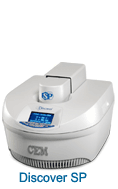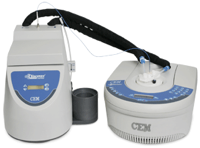The three CEM Discover microwave units we have act as the workhorses for the group. The flexibility of the system and its modular design opens avenues for a wide range of conditions and variables to be investigated, giving it great versatility in the laboratory. The Discover allows us to run reactions at up to 300°C and 300 psi in 10-mL or 80-mL sealed vessels. Additionally, open-vessel reactions can be run using conventional round-bottom flasks (up to 125 mL) equipped with a reflux condenser. The S-Class is the newest in the CEM Discover series and their premier microwave synthesis system. By using fuzzy logic, the S-Class offers improved reaction parameter monitoring and control; a benefit to us in some of our more complex experiments. The new Synergy™ software gives us greater capability to follow reactions in real-time as well improved flexibility in data storage and output.


An interesting accessory to the Discover line is the CoolMate external cooling device. This device essentially allows us to run reactions at sub-ambient temperatures but with the introduction of significant microwave power. In principle, this could open up avenues for running reactions at room temperature or below in minutes that conventionally take many hours. Reactions involving thermally unstable substrates such as carbohydrates or main-group organometallics may benefit from this technique. In essence, this apparatus takes the concept of simultaneous cooling to an extreme. The apparatus allows us to work in temperature ranges from -50°C to 50°C, the temperature being controlled by the rate of flow of the cryogenic fluid as well as the microwave power used.